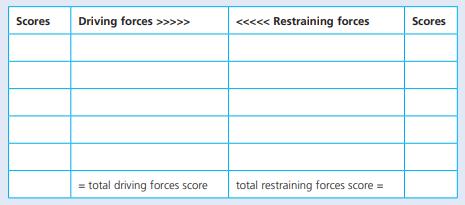Question: Force-field analysis is a method for assessing the issues supporting and blocking movement towards a given set of desirable outcomes, called the target situation. The
Force-field analysis is a method for assessing the issues supporting and blocking movement towards a given set of desirable outcomes, called the ‘target situation’. The forces can be scored, say from 1 (weak) to 10 (strong), to calculate (approximately) the balance of forces.
If the driving forces are overwhelming, then the change can go ahead without significant problems. If the resisting forces are overwhelming, then the change may have to be abandoned, or delayed until conditions have improved.
If the driving and resisting forces are more or less in balance, then the force-field analysis can be used to plan appropriate action. The extent to which the force-field is balanced is a matter of judgement. Used in a group setting, this method provides a valuable way to structure what can often be an untidy discussion covering a wide range of factors and differing perceptions.
For this analysis, your target situation is ‘to double the time that I spend studying organizational behaviour’. In groups of three, complete the analysis using the following table as a guide. First identify as many driving and restraining forces as you can. Then, reach a group consensus on a score for each of those forces, from 1 (weak) to 10 (strong). Finally for this stage of the analysis, calculate the totals for each side of the force-field.

When you have completed this analysis, and added the scores, estimate the probability (high, medium, or low) of reaching your target situation if the force-field stays the same. Now draw a practical action plan for managing the field of forces that you have identified in order to increase the probability of reaching the target situation. In devising your action plan, remember that:
1. Increasing the driving forces can often result in an increase in the resisting forces. This means that the current equilibrium does not change, but is maintained with increased tension.
2. Reducing the resisting forces is preferable as this allows movement towards the desired outcomes or target situation without increasing tension.
3. Group norms are an important force in shaping and resisting change.
Scores Driving forces >>>>> = total driving forces score < < < < < Restraining forces total restraining forces score = Scores
Step by Step Solution
3.54 Rating (161 Votes )
There are 3 Steps involved in it

Get step-by-step solutions from verified subject matter experts


